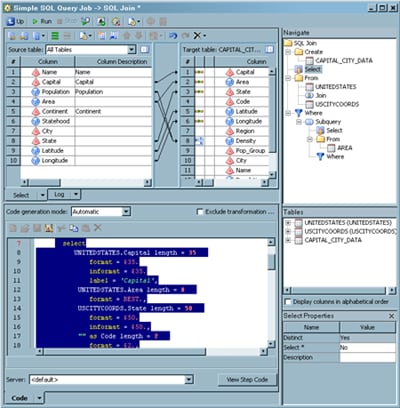Configuring a SELECT Clause
Problem
You want
to configure the SELECT clause for an SQL query that is used in a
SAS Data Integration Studio job. This clause defines which columns
are read from the source tables and which columns are saved in the
query result tables. You must review the automappings for the query,
and you might need to create one or more derived expressions for the
query.
Tasks
Configure the SELECT Clause with the Select Tab
-
Perform the following steps if you need to create a derived expression for a column in the target table for the sample query:
-
Click the drop-down menu in the Expression column in the Target table field, and click Advanced. The Expression Builder window displays. For information about the Expression Builder window, see Expression Builder.
-
-
Review the data tables in the Source table field and the Target table field to avoid mapping errors. For example, the Name column in the US source table uses the full names of the states, such as California. However, the State column in the CITY target table uses the two-letter state abbreviation (CA). In this case, the column width for the State column must be increased to 50 in order to accommodate the data in the Name column. Also, the Distinct property in the Select Properties pane is set to Yes. This property determines that only the first matching record for each matching condition is included in the output. Note that the SQL code for the SELECT clause is highlighted on the Code tab.
Copyright © SAS Institute Inc. All rights reserved.
